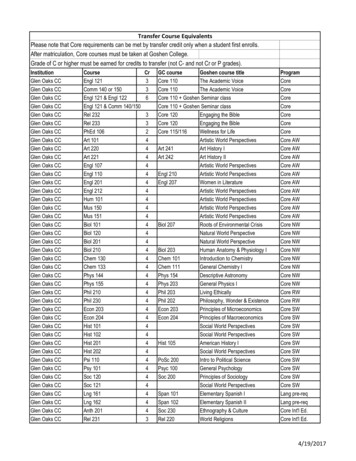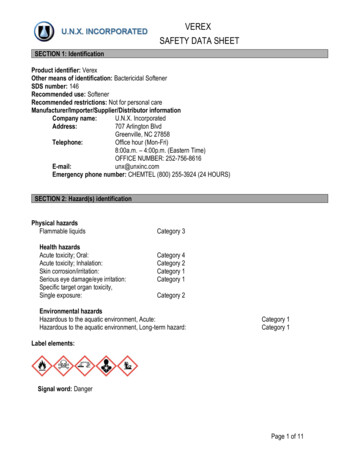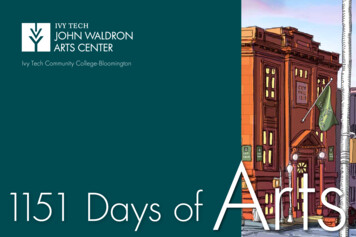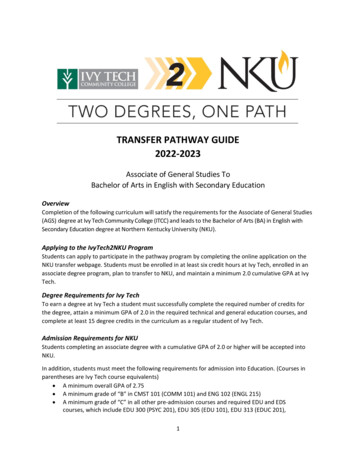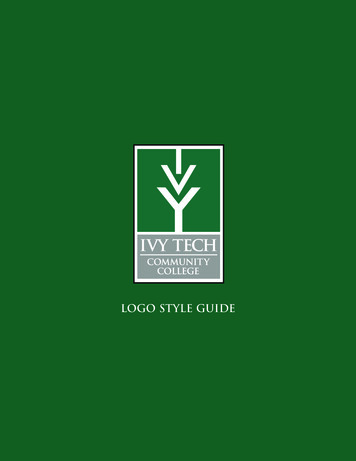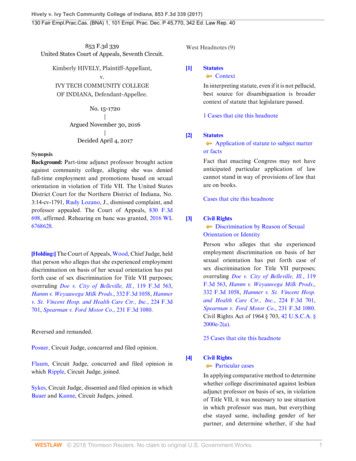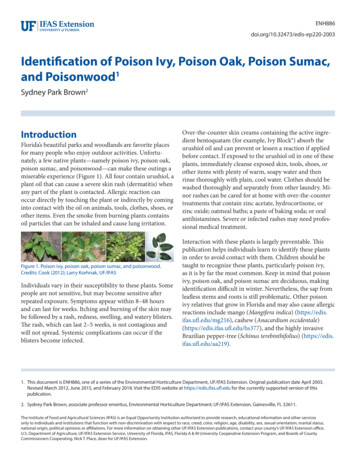
Transcription
on of Poison Ivy, Poison Oak, Poison Sumac,and Poisonwood1Sydney Park Brown2IntroductionFlorida’s beautiful parks and woodlands are favorite placesfor many people who enjoy outdoor activities. Unfortunately, a few native plants—namely poison ivy, poison oak,poison sumac, and poisonwood—can make these outings amiserable experience (Figure 1). All four contain urushiol, aplant oil that can cause a severe skin rash (dermatitis) whenany part of the plant is contacted. Allergic reaction canoccur directly by touching the plant or indirectly by cominginto contact with the oil on animals, tools, clothes, shoes, orother items. Even the smoke from burning plants containsoil particles that can be inhaled and cause lung irritation.Figure 1. Poison ivy, poison oak, poison sumac, and poisonwood.Credits: Cook (2012); Larry Korhnak, UF/IFASIndividuals vary in their susceptibility to these plants. Somepeople are not sensitive, but may become sensitive afterrepeated exposure. Symptoms appear within 8–48 hoursand can last for weeks. Itching and burning of the skin maybe followed by a rash, redness, swelling, and watery blisters.The rash, which can last 2–5 weeks, is not contagious andwill not spread. Systemic complications can occur if theblisters become infected.Over-the-counter skin creams containing the active ingredient bentoquatam (for example, Ivy Block ) absorb theurushiol oil and can prevent or lessen a reaction if appliedbefore contact. If exposed to the urushiol oil in one of theseplants, immediately cleanse exposed skin, tools, shoes, orother items with plenty of warm, soapy water and thenrinse thoroughly with plain, cool water. Clothes should bewashed thoroughly and separately from other laundry. Minor rashes can be cared for at home with over-the-countertreatments that contain zinc acetate, hydrocortisone, orzinc oxide; oatmeal baths; a paste of baking soda; or oralantihistamines. Severe or infected rashes may need professional medical treatment.Interaction with these plants is largely preventable. Thispublication helps individuals learn to identify these plantsin order to avoid contact with them. Children should betaught to recognize these plants, particularly poison ivy,as it is by far the most common. Keep in mind that poisonivy, poison oak, and poison sumac are deciduous, makingidentification difficult in winter. Nevertheless, the sap fromleafless stems and roots is still problematic. Other poisonivy relatives that grow in Florida and may also cause allergicreactions include mango (Mangifera indica) (https://edis.ifas.ufl.edu/mg216), cashew (Anacardium occidentale)(https://edis.ifas.ufl.edu/hs377), and the highly invasiveBrazilian pepper-tree (Schinus terebinthifolius) (https://edis.ifas.ufl.edu/aa219).1. This document is ENH886, one of a series of the Environmental Horticulture Department, UF/IFAS Extension. Original publication date April 2003.Revised March 2012, June 2015, and February 2018. Visit the EDIS website at https://edis.ifas.ufl.edu for the currently supported version of thispublication.2. Sydney Park Brown, associate professor emeritus, Environmental Horticulture Department; UF/IFAS Extension, Gainesville, FL 32611.The Institute of Food and Agricultural Sciences (IFAS) is an Equal Opportunity Institution authorized to provide research, educational information and other servicesonly to individuals and institutions that function with non-discrimination with respect to race, creed, color, religion, age, disability, sex, sexual orientation, marital status,national origin, political opinions or affiliations. For more information on obtaining other UF/IFAS Extension publications, contact your county’s UF/IFAS Extension office.U.S. Department of Agriculture, UF/IFAS Extension Service, University of Florida, IFAS, Florida A & M University Cooperative Extension Program, and Boards of CountyCommissioners Cooperating. Nick T. Place, dean for UF/IFAS Extension.
Poison Ivy (Toxicodendronradicans)Poison ivy grows in shady or sunny locations throughoutFlorida. It can be a woody shrub up to 6 feet tall or a vineup to 150 feet tall that climbs high on trees, walls, andfences or trails along the ground (Figure 2). All parts ofpoison ivy, including the hairy-looking aerial roots, containurushiol at all times of the year, even when bare of leavesand fruit in winter. Plants are frequently abundant alongold fence rows and the edges of paths and roadways. Leafforms are variable among plants and even among leaveson the same plant; however, the leaves always consist ofthree leaflets. The old saying “Leaflets three, let it be” is areminder of this consistent leaf characteristic. Leaflets canbe 2–6 inches long and may be toothed or have smoothedges. The stem attaching the terminal leaflet is longer thanstems attaching the other two. Leaves emerge with a shinyreddish tinge in the spring and turn a dull green as they age,eventually turning shades of red or purple (Figure 3) in thefall before dropping.Figure 3. Poison ivy vine showing single leaf (in circle) and fall redcolor.Credits: UF/IFASFigure 4. Poison ivy mature fruits.Credits: Cook (2012)Figure 2. Poison ivy leaves (consisting of three leaflets) and flowers.Credits: UF/IFAS Center for Aquatic and Invasive PlantsFlowers and fruit are always in clusters on slender stemsthat originate in the leaf axils (angles), between the leavesand woody twigs. The berrylike fruits are round andgrooved with a white, waxy coating. They are attractive tobirds. The leaves and fruit are an important food source fordeer (Figure 4).Identification of Poison Ivy, Poison Oak, Poison Sumac, and PoisonwoodA common poison ivy look-alike is the native Virginiacreeper (Parthenocissus quinquefolia) (Figure 5). Thistrailing or climbing vine can be distinguished from poisonivy rather easily by its five divided palmate leaflets. Otherdistinguishing features include blue-black berries andtendrils that end in tiny sticky pads that attach to trees andother surfaces. In winter, the leaves of Virginia creeper turnred and drop from the plant (Figure 6). For more information, see https://edis.ifas.ufl.edu/fp454.2
Like poison ivy, a single poison oak leaf consists of threeleaflets. The stem attaching the terminal leaflet is longerthan the stems attaching the other two. One distinguishingfeature of poison oak is its lobed leaves, which give it theappearance of an oak leaf. The middle leaflet usually islobed alike on both margins, and the two lateral leaflets areoften irregularly lobed (Figure 7). Leaf size varies considerably, even on the same plant, but leaves are generally about6 inches long. Another distinguishing feature is that the leafstems and leaflets have a coating of fine hair.Figure 5. Virginia creeper.Credits: Larry Korhnak, UF/IFASFigure 7. Poison oak lobed leaves and immature green fruit.Credits: Larry Korhnak, UF/IFASLeaflets emerge with a reddish tinge in the spring, turngreen, and then assume varying shades of yellow and red inthe fall before dropping. As with poison ivy, the flowers andfruit arise from the leaf axils in clusters. The small flowersare white, and the ripe fruit is round, light tan, waxy, andgrooved (Figure 8).Figure 6. Virginia creeper showing vining habit and winter color.Credits: Sydney Park Brown, UF/IFASPoison Oak (Toxicodendronpubescens)Poison oak, also known as Atlantic poison oak, oakleaf ivy,or oakleaf poison ivy, is a low-growing, upright shrub thatis about 3 feet tall. It is found in dry, sunny locations anddoes not tolerate heavy shade. Poison oak is confirmed innorth and central Florida, from Levy and Marion Countiesnorthward.Identification of Poison Ivy, Poison Oak, Poison Sumac, and PoisonwoodFigure 8. Poison oak mature fruit.Credits: Cook (2012)3
Poison Sumac (Toxicodendronvernix)More allergenic than poison ivy and poison oak is poisonsumac, a deciduous woody shrub or small tree that grows5–20 feet tall and has a sparse, open form (Figure 9). Itinhabits swamps and other wet areas, pine woods, andshady hardwood forests. In Florida, poison sumac has beenconfirmed in the north and central regions, as far south asPolk County.Figure 10. Poison sumac leaflets, reddish stems, and immature greenfruit.Credits: Larry Korhnak, UF/IFASFigure 9. Poison sumac.Credits: Cook (2012)Poison sumac leaves consist of 7–13 leaflets arranged inpairs with a single leaflet at the end of the midrib. Distinctive features include reddish stems and petioles (Figure 10).Leaflets are elongated, oval, and have smooth margins. Theyare 2–4 inches long, 1–2 inches wide, and have a smooth,velvety texture. In early spring, the leaves emerge brightorange. Later, they become dark green and glossy on theupper leaf surface and pale green on the underside. In theearly fall, leaves turn a brilliant red-orange or russet shade.The small, yellowish-green flowers are borne in clusters onslender stems arising from the leaf axils. Flowers matureinto ivory-white to gray fruits resembling those of poisonoak or poison ivy, but they are usually less compact andhang in loose clusters of up to 10–12 inches in length(Figure 11).Winged sumac (Rhus copallinum) has a similar appearancebut is a nonallergenic relative that grows throughoutFlorida. It can be distinguished from poison sumac mostreadily by its 9–23 leaflets, clusters of red berries, and thewinged rachis between the leaflets (Figure 12).Identification of Poison Ivy, Poison Oak, Poison Sumac, and PoisonwoodFigure 11. Poison sumac mature fruit in winter.Credits: Cook (2012)4
Figure 12. Winged sumac.Credits: Larry Korhnak, UF/IFASPoisonwood (Metopium toxiferum)Poisonwood is an evergreen shrub or tree that grows25–35 feet tall in hammocks, pinelands, and sandy areasnear saltwater. It is particularly abundant in the FloridaKeys. As of this writing, poisonwood’s range has only beenconfirmed in five counties in south Florida: Martin, PalmBeach, Broward, Miami-Dade, and Monroe. The tree hasa spreading, rounded form with a short trunk and archinglimbs with drooping branches. The bark varies in colorfrom reddish brown to gray, depending on the habitat, andhas oily patches of sap on the surface; older trees have scalybark (Figure 13). Each leaf is comprised of three to sevenoval leaflets, although five leaflets are typical. Leaves areglossy and dark green above, paler underneath, and havesmooth margins (leaf edges). Irregular blotches of resindot the surface of many of the leaflets (Figure 14). The fruitis ½ inch long, oval, yellow to orange in color, and hangsin loose clusters (Figure 15). The poisonwood fruit is animportant food source for the threatened white-crownedpigeon.Figure 14. Poisonwood leaves with dots of resin.Credits: Kim Gabel, UF/IFASFigure 15. Poisonwood fruit.Credits: Larry Korhnak, UF/IFASAcknowledgementsFigure 13. Poisonwood bark variations.Credits: Kim Gabel, UF/IFASDo not walk where poisonwood is known to grow duringa rainstorm. Rainwater dripping off the poisonwood leavescontains urushiol, which causes contact dermatitis.Identification of Poison Ivy, Poison Oak, Poison Sumac, and PoisonwoodThe author wishes to thank Mary Derrick, former horticulture program assistant, for her help with the research andediting of this publication, and Dan Culbert, retired UF/IFAS Extension Okeechobee County horticulture agent,as well as Kim Gabel, UF/IFAS Extension Monroe Countyhorticulture agent, for their reviews and contributions. Theoriginal publication was written by Pat Grace, former UF/IFAS Extension Putnam County horticulture agent andSherrie Lowe, Putnam County Master Gardener; UF/IFASExtension, Gainesville, FL 32611.5
ReferenceCook, W. 2012. “Trees, Shrubs, and Woody Vines of NorthCarolina.” Accessed February 2012. http://www.duke.edu/ cwcook/trees/.Additional ResourcesCenters for Disease Control and Prevention. 2012. “Poisonous Plants.” Accessed March 2012. http://www.cdc.gov/niosh/topics/plants/Hossler, E. W. 2010. “Botanical Briefs: Poisonwood (Metopium toxiferum).” Cutis 85(4): 178–179.Institute for Systemic Botany. 2012. “Atlas of FloridaVascular Plants.” Accessed February 2012. http://florida.plantatlas.usf.edu/.Mayo Clinic Online. 2012. “Poison Ivy Rash.” AccessedMarch 2012. 4.MedLine Plus. 2012. “Poison Ivy – Oak – Sumac Rash.”Accessed February 2012. 0027.htm.Nellis, D. W. 1997. Poisononus Plants and Animals of Floridaand the Caribbean. Sarasota, FL: Pineapple Press.UF/IFAS (University of Florida Institute of Food andAgricultural Sciences). 2012. “Forest Trees and CompanionPlants.” Accessed March 2012. http://www.sfrc.ufl.edu/4h/Trees Plants/trees plants.html.Identification of Poison Ivy, Poison Oak, Poison Sumac, and Poisonwood6
Poisonwood is an evergreen shrub or tree that grows 25-35 feet tall in hammocks, pinelands, and sandy areas near saltwater. It is particularly abundant in the Florida Keys. As of this writing, poisonwood's range has only been confirmed in five counties in south Florida: Martin, Palm Beach, Broward, Miami-Dade, and Monroe. The tree has


